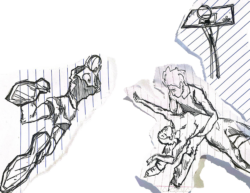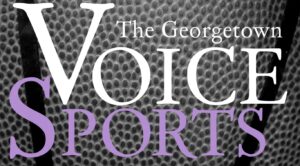Your favorite full-service feature of this gray box is on top of things this month. It’s February, the post-NFL, All-Star-Game-filled month of cold weather and important birthday’s (mine).
Pro Bowl. Already forgot about it. NHL All-Star Game should be renamed the Lemieux Cup since everyone else does their best impersonation of him.
This weekend, we finally get the gem of February, the NBA’s showcase?All-Star weekend. It’s actually right here in D.C., so if you want, you can run down to the Washington Convention Center for autographs or the MCI Center to see shooting (that 2-ball game), long-range bombing (what’s better than 25 threes in 60 seconds), dunking (sadly without Vince Carter), youth in action (the sophomore-rookie challenge) and finally, the greatest athletes in the world all playing at the same time (the All-Star Game itself).
Yes, it’s a bit corporate, a bit fake feeling and there’s not much intensity, but it’s still great.
Most importantly: it gives those of you that have been a bit too focused on football a chance to catch up and realize a few things:
First, Allen Iverson is the only real Georgetown star these days. Patrick Ewing looks great on that highlight reel they show before Hoya games at MCI, but he didn’t even think about making the game.
Alonzo Mourning is still the second best center in the league, but this season, his injury is the only reason Dikembe Mutombo made the team.
Still, Iverson should be enough. This season, the Hoyas are good on their own. We can live through guys that are still here. It doesn’t hurt that Iverson might have an official MVP Award to add to his “best player from G-town” status.
Second, the West is a conference of amazing power forwards. As recently as three years ago, Karl Malone beat out Jordan for the MVP. Now, he’s only the fifth best guy at his position in the West. The East, in contrast, has zero power forwards. (Anthony Mason is in between small and power forward.) The corollary is that the East has a phenomenal set of shooting guards in Iverson and McGrady. If Lakers Coach Phil Jackson has his way and Kobe sits out, the West will have Michael Finley going against Iverson, McGrady, Houston, Sprewell (he’s a guard, even if he plays forward for the Knicks), Stackhouse and Ray “Jesus Shuttlesworth” Allen.
(Now we’ll throw in some knowledge that has nothing to do with the game itself so that you can be smart when you start watching the regular season.)
Third, the Lakers can’t get along because their shooting guard is scoring too much. Simple facts: Kobe is good. Shaq is a whole lot better. When Kobe scores more than Shaq on a consistent basis, L.A. isn’t so good any more. The Lakers still have the two-of-the-five-best-players-in-the-league thing, so don’t count them out, but in general follow the rule. Kobe > Shaq = L.A. going down.
It’s not as iron-clad as the “When Don Reid scores more than Grant Hill, you know you are going to lose” rule, but it’s a good theory.
A few similar rules for some other shooting guards: Jerry Stackhouse only scores more than 25 points per game if his team is terrible. Same goes for Tracy McGrady, though Orlando is a whole lot better than Detroit. At some point, a player scores too many points. Kobe, Stackhouse and McGrady are all way past the point of bringing their teams down for personal game.
In contrast, Philadelphia is getting along because Iverson, despite his high number of shot attempts, has the respect of his teammates and scores in a manner that makes the rest of the team play hard on defense.
So, let’s recap: The East is led by shooting guards, the West by power forwards. When a shooting guard scores too much, the team goes down, unless he’s the best Hoya in the league. A few months from now, we’ll find out whether an Iverson trumps a power forward, unless Shaq trumps them all.




